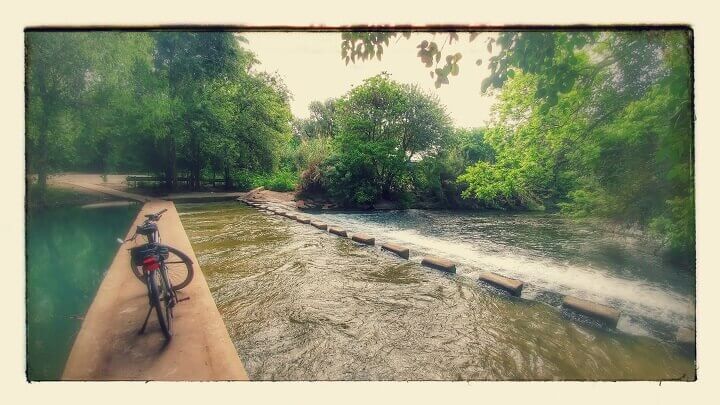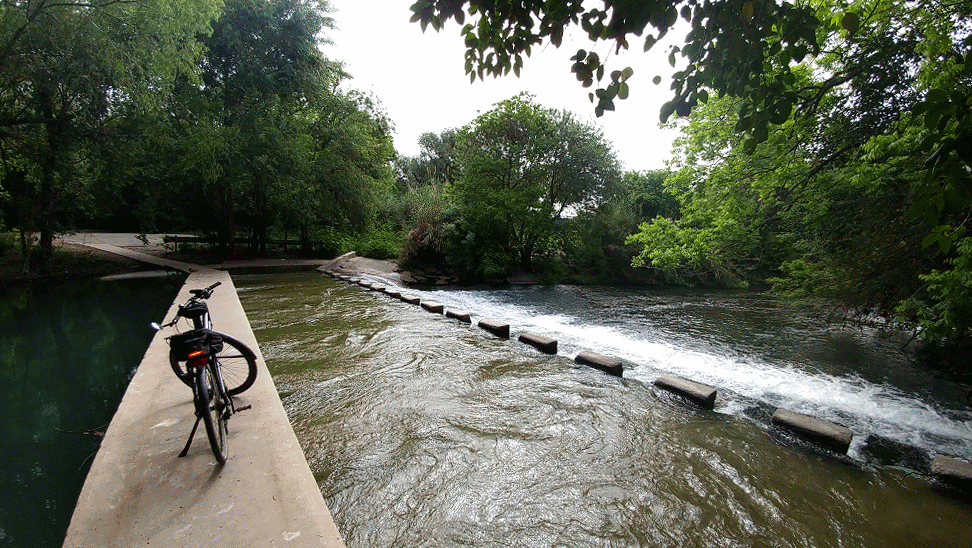
After Hurricane Harvey made landfall and motorists in San Antonio besieged gas stations like frantic bank customers in “Mary Poppins,” there’s probably never been a better time to try something that lets you avoid gas stations altogether — commuting by bicycle.
I’m here to help.
We can all come up with excuses to avoid riding a bike to work or school. I know, because I made those same excuses, too. But in January, I finally bought a snazzy Cannondale Contro and became a bike commuter.
It’s been quite the journey. I ride a few days a week, and so far I’ve gradually saved about $350 in gas and maintenance expenses for my car. On the days I rode my bike, I avoided burning fossil fuels while burning an estimated 55,800 calories over the course of 1,000 miles.
Along the way, I dragged myself out of the insulated bubble of the automobile and explored parts of the city I’ve never bothered to really see before.
I’m not saying cycling is for everyone or that we all should abandon our vehicles. I live less than 5 miles away from downtown (although my usual biking route is longer). I can avoid busy roads most of the way. There’s a shower at the office I can use in the summer. When I need to drive somewhere during work hours, I use Lyft.
If you’re in a similar situation, here are some answers to questions you might be asking about the pros and cons of commuting by bicycle and whether it’s worth it:
How strenuous is bicycle commuting?
That depends on you and your route. I live in the Woodlawn Lake area and typically ride 6 to 7 miles to and from work on a route with modest hills.
I was already an avid jogger and hiker, but cycling wore me out after the first few commutes. I was sore and tired.
I got used to it. You will, too.
According to my Sports Tracker smart phone app, I’ve ridden more than 1,000 miles since January 2017 and burned nearly 56,000 calories. The vast majority of those trips were to and from work. I didn’t always feel like doing it. But most of the time it was fun and challenging and it slowly became part of my routine.
Is cycling dangerous?
San Antonio has a bad reputation for bicycling, much of it deserved. There are, indeed, motorists who don’t like sharing the road with cyclists and some streets are an obstacle course of bumps, debris and potholes.
One of the best ways to stay safe on a bicycle is to make sure drivers can see you. Buy front and rear LED lights that are bright and blinky. I bought mine on Amazon and they work fine. Shop around and find something that works for you. So far I’ve rarely had a problem with a motorist pulling in front of me or failing to yield. I’m not saying it’s never happened. But it’s rare.
Related: Interactive map of road-rage incidents in San Antonio
When I was deciding whether to make the jump into bike commuting, I spent a lot of time looking at Google Maps figuring out how I was going to get to and from work and avoid busy roads. Why ride on Broadway, where some drivers act like they’re Mad Max extras, when there’s a peaceful, parallel bike path that runs past Brackenridge Golf Course, dips under U.S. 281, then takes you to the pleasant Museum Reach of the River Walk?
Find those quieter routes and side streets. Google offers a bike-route feature in its maps app that can help.
Don’t motorists have to share the road with cyclists?
Yes, but not every driver likes it. I had someone tailgate me on Fredericksburg Road one time when we were the only two people on the road. It was weird. Sometimes cars and trucks speed by a little too close for comfort.
But motorists don’t cause every problem. Cyclists also have to obey the rules of the road. And not just that — they need to be smart. Spend some time learning how to be an observant, safe cyclist. Check out this guide that helped me. The title says it all: “How to not get hit by cars.”
Among the lessons: Don’t ride against traffic — it’s actually riskier than riding with the flow of traffic. Look out for parked cars — someone might open a door in front of you. Don’t ride on sidewalks — it’s a bad idea, plus it’s illegal in San Antonio.
You don’t always have to move as far to the right as possible to let traffic go by. The Texas Department of Transportation publishes a guide that notes cyclists can use the full lane if the street is too narrow to safely accommodate cars and bicycles at the same time.
Remember, you’re riding a type of vehicle. You have to be comfortable cruising among other vehicles.
To avoid feeling vulnerable riding with the flow of traffic, you can buy a mirror that attaches to your left handlebar or your helmet that lets you check your blindspot and see what’s coming up behind you.
I also bought a waterproof GoPro I attach to my helmet in case I have any close calls (or see something cool on my ride). Let’s say somebody clips me and takes off. I figure it will probably happen so fast I won’t be able to get a license plate number. The GoPro gives me a chance to take some video of that number, or at least get a good description of the car.
You can buy an air horn that attaches to your bike. It works as advertised — it’s loud and lets drivers know you’re there. I’ve only had to use this once, when I was riding at the roundabout on Fulton and Blanco and a car failed to yield to me.
For a less obtrusive warning, don’t forget a bike bell. You’ll need this for pedestrians, especially if you ride on the River Walk or one of the many creek trails in San Antonio.
What’s the best bicycle to buy?
For me, buying the bike was more daunting than actually riding the thing. There are so many choices out there.
You’re faced with three types: Sturdy mountain bikes, fast road bikes or hybrids of the two. From there you can dive into countless brands and variations.
I spent an unhealthy amount of time researching bikes and reading reviews. I finally lucked out at REI, where I found a slightly used Cannondale Contro for sale. REI employees are amazingly helpful and they also offer a free tune up you can use later if you buy a bike there.
You’ll want to find something with fenders and a bike rack or buy those extras later. Even if it’s not raining, sometimes you have to ride through puddles and you don’t want mud staining your work clothes. The bike rack helps you carry the standard gear of a bike commuter — a change of clothes, patches and spare tires, a pump, a bike lock and a multitool.
The best advice I can give is don’t get too hung up on finding the perfect bike. Find a decent one and start riding.
Can you wear work clothes or do you get all sweaty?
Depending on the weather and the distance of your commute, you can totally wear work clothes. There’s a lot of breathable, stretchy, moisture-wicking clothing out there, even for office attire. Check out Ministry of Supply if you have money to burn. Their stuff is expensive but their office slacks feel like yoga pants.
In mild weather I work up a bit of a sweat but I cool off at the office. Either I don’t stink or my colleagues are really nice. In the oppressively hot San Antonio summer, I wore exercise clothes to work and brought a change of clothes for the office, which has a shower, which I most definitely used. The ride home in San Antonio is brutal in summer. When you’re moving, the wind helps cool you off, but bring a water bottle and use it.
For chilly weather, check out this helpful guide that offers some tips about bundling up. When you ride a bike there’s going to be a windchill factor. But you’re also going to get warmer as you ride.
What gear should you buy for bicycle commuting?
Cycling makes you spend a little time thinking about the logistics of what you need to get from Point A to Point B. A bike drags you out of your comfort zone.
Did you prepare for the chance of rain today? Do you have your patch kit and other tools? Do you know how to change a flat if you need to?
In the summer, you’ll probably have to shower at your workplace after your morning ride, which means you’ll have to pack your clothes and gear into a backpack, messenger bag or saddlebags. I attached a trunk bag to my biake rack, and put the rest of my stuff in a Timbuk2 messenger bag. Messenger bags are bit more uncomfortable than backpacks, but they do allow more air flow to cool off your back. If you use a messenger bag, buy a cross strap to prevent it from sliding around.
You’ll have to come up with a system to keep track of all your stuff. Use a checklist to make sure you bring everything … you don’t want to show up sweaty at the office and realize you forgot fresh socks.
In the summer, I leave all my toiletries in a duffel bag under my desk so I don’t have to carry them back and forth. It’s just extra weight and space you don’t need to worry about.
Is cycling worth the hassle?
What I learned in 1,000 miles of bicycle commuting is you really get to experience and explore the city in ways that just aren’t the same in a car.
I’ve driven down Mulberry Avenue a million times but never bothered to take a detour on Avenue A, a narrow side street that winds along the shady San Antonio River.
Well, things changed on my bike. One day I was riding by that bumpy little street and decided to find out where it goes.
It turns out, the street ends at a cool pedestrian crossing that spans the river. It was a tranquil setting — and I had no idea it existed until I bought a bike.
All kinds of things good things happen when the wind is in your face.
How much money do you save riding a bike?
When I drive my car to work, it’s 8.8 miles round trip. IRS guidelines say driving a car costs 54 cents a mile in fuel, insurance and maintenance costs. So I’m saving about $4.75 a day every time I ride my bike.
That might not sound like much but it adds up over time. I’ve ridden to and from work 75 times so far, which means I’ve saved about $350.
Keep in mind, I had to buy my $680 bike and the gear to go with it, so it will take several more months of commuting to break even. I also got extravagant with a $300 GoPro, although I use that for other things besides biking. It’s easy to get sucked into buying tons of gear and apparel that can quickly get expensive if you’re not careful.
But compare that to how much it costs to own a car. Even if you go a little crazy on a bike-gadget shopping spree, riding a bicycle even a few times a week saves money that will gradually add up over the years.
Plus, you don’t have to worry about those long Mary Poppins lines at the gas stations.
Every bicycle commute is a small victory. You got off your ass and did something to stay healthy. You did something to keep a car off the road and help the environment. And you did something to break out of your vehicular rut and challenge yourself.
Those small victories add up.

Did I overlook any good tips? Leave a comment or let me know and I’ll update this post.
Update No. 1: Abigail Rodriguez, San Antonio’s former bike coordinator who is now with VIA Metropolitan Transit, emailed me some useful tips I didn’t know.
The Alamo Area Metropolitan Planning Organization offers a free, hourlong “Street Skills” class for anyone 14 years old and older who wants to brush up on their cycling skills. If you sign up in advance, you get a free helmet and set of bike lights. Nice.
VIA buses have bike racks. Abigail said she knows some cyclists who can’t shower at the office in the summer, so they’ll take the bus in the mornings, change at the end of the day and ride home from work.
“You only get half the workout, but the summer days can be brutal, even in the morning,” Abigail told me.
Update No. 2: The MPO publishes a bicycle map that shows “traffic stress” on local roads, giving you an idea of how comfortable cyclists might be riding on any given route.
Here’s an interactive version of the traffic stress map I downloaded from the MPO’s website. Click on a colored trail or road to view more information about it:
Check back here for new updates.
A note about affiliate links: Sometimes I blog about stuff that helps journalists. I pay for all the products I review on my blog. To help defray those costs, I use Google ads and Amazon’s affiliate advertising program, which provides a way for sites to earn commissions by linking to Amazon.com. There’s no extra cost to you, and I’ll never link to stuff I don’t like or try to make you buy something that sucks. These reviews are my honest opinions. Thanks for reading.




Hey John! The MPO has a bike map that suggests better bike routes for the SA area. Check with Cecilio Martinez.
Also as Abigail mentioned, smart bike commuters research VIA bus routes and use them as necessary.
Great story.
Thanks Scott, I’ll add the map’s link to the post, looks helpful.